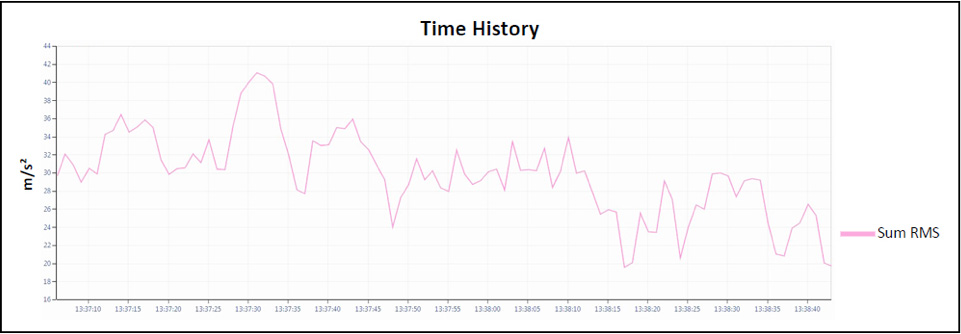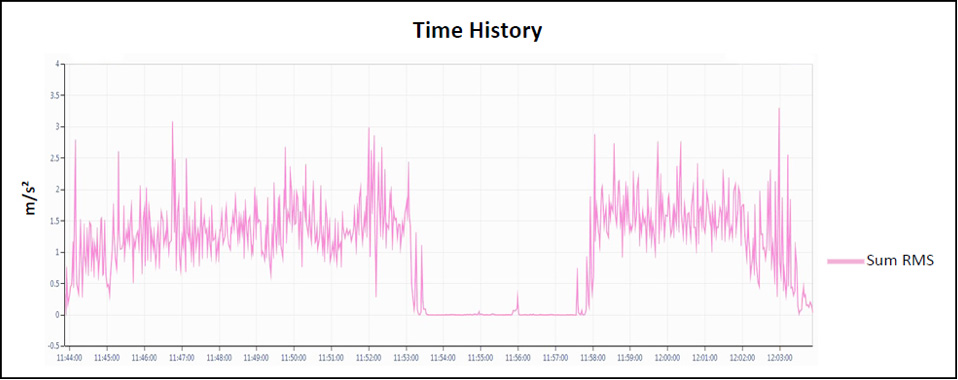Main Menu
- Home
- Products
- Applications
- Product Support
- Service
- Learn
- About Us
- Contact Us
Larson Davis' Technical Sales Specialist, Rick, likes to do yardwork, but he wants to stay safe too. Consider the time Rick's leaf blower broke a fin, causing an imbalance. Using a Larson Davis Human Vibration Meter Model HVM200 while operating the leaf blower, the data collected showed an A(8) of almost 1.8 m/s2 in less than 2 minutes. After less than 15 minutes of operation, he would
have reached the exposure limit value of 5.0 m/s2 A(8). Operating any tool with this level of vibration over time would create a significant risk of permanent damage.
What about the day he cut the grass on his riding mower while measuring with the HVM200 and a SEN207 triaxial seat
pad accelerometer? He only mowed for 20 minutes (during that time, he ran out of gas, as you can see in the Time History graph below), but the data collected showed that he could have safely mowed for well over 3 hours... if only his gas
tank were large enough!
While Rick's tests confirmed that he should buy a new leaf blower before all the trees in his yard drop their leaves, they also drive home the fact that human vibration exposure is serious. What may seem like an irritating piece of equipment
could silently be causing harm to you and your team.
Need to make sense of the numbers? There are no official national standards governing human vibration in the US, but there has been significant research in the EU and Australia, where standards have been in place since 2002 and 2001 respectively.
Tool and equipment manufacturers may publish vibration values, but in practice the vibration experienced by the user can vary widely depending on the condition of the tool, tool accessories (such as drill bits), the type of work surface, the worker’s
posture or technique, or other factors. The best way to determine if a particular tool is safe for a given user in a given situation is to measure the vibration with a human vibration meter.
In fact, by providing simple to understand measurements
correlating with published standards, a human vibration meter such as the Larson Davis HVM200 simplifies
the process of protecting the workplace from vibration-related injury. Simply wear the meter connected to a triaxial accelerometer mounted via an adapter at the location in which vibration is entering the body and go about typical work tasks. This guide to recommended weightings helps users understand how to set
up the HVM200 meter for specific measurement scenarios. View results in the HVM200 App or G4 Utility Software. Both display data in an easy-to-understand format, including values such as overall A(8) daily vibration exposure, vibration dose values,
safe operating time limits, and exposure points.
Let’s take a look at some of that terminology. A(8), or daily vibration exposure, is the average vibration magnitude (calculated from the frequency-weighted RMS acceleration measurements awx, awy, and awz and
the measured exposure period Texp) over an 8-hour workday for a given piece of equipment in a given situation. Whether a worker wears the HVM over a few hours or all day, A(8) is calculated and reported. What’s considered an acceptable
A(8) varies based on type of vibration (vibration in the whole body has different limits than vibration through the hand-arm) and location (various governmental agencies have different regulations).
Allowed exposure time (or the time the
user can safely operate the tool or piece of equipment) is reported on the HVM using the EU standards of Exposure Action Value (EAV) and Exposure Limit Value (ELV). EAV is considered the vibration
level at which there is an increased risk of damage to human health. Controls (either administrative controls or engineering controls – improvements to the tools, vibration-absorbing materials, vibration-damped equipment, etc.) to limit risk
should be considered. ELV is the level at which the safe limits of vibration have been exceeded and risk of injury is severe. EAV and ELV are reported as an overall A(8) daily vibration exposure or with an exposure points system.
Note that
another calculated parameter for whole body vibration reported by the meter is Vibration
Dose Value. VDV is especially useful for cases in which the worker is exposed to impulsive vibration such as shocks or jolts. VDV increases with measurement time, unlike the daily vibration exposure, which is an averaged value. Vibration
Dose Value does not apply for hand-arm vibration.
| EU Exposure Action Value (EAV) | EU Exposure Limit Value (ELV) | |||||
|---|---|---|---|---|---|---|
| m/s2 A(S) | Exposure Points | Vibration Dose Value (VDV) (m/s1.75) | m/s2 A(S) | Exposure Points | Vibration Dose Value (VDV) (m/s1.75) | |
| Hand-Arm | 2.5 | 100 | N/A | 5.0 | 400 | N/A |
| Whole Body | 0.5 | 100 | 9.1 | 1.15 | 529 | 21 |
Although there are no federal governmental regulations in the US for Human Vibration, the American Conference of Governmental Industrial Hygienists (ACGIH®), a scientific non-profit whose stated purpose is the advancement of occupational and environmental health, has published Human Vibration standards called Action Limits (AL) and Threshold Limit Values (TLV®). They are measured in the same units (m/s2 A(8)) as the EU standards.
| ACGIH Action Limit (AL) m/s2 A(8) | ACGIH Threshold Limit Values (TLV) m/s2 A(8) | |
|---|---|---|
| Hand-Arm | * | 5.0 |
| Whole Body | 0.43 | 0.86 |
*No action limit is given
Other reported parameters from the HVM200 are A(8) Act. and A(8) Exp., reported in units of hours. These are the total calculated times an individual could use the equipment per day before reaching the user-definable EAV and ELV, respectively. In the HVM200, EAV and ELV are set by default to match with EU standards but can be customized according to your needs.
Having trouble developing a plan to assess human vibration? Consider these helpful guides as a starting point:
Other helpful Human Vibration Resources:
From evaluating tools for purchase to implementing a whole-plant plan for monitoring and mitigating human vibration exposure (and even to determining the safety of your yard work regimen!), Larson Davis’ HVM200 Human Vibration meter provides the needed data in a clear, easy-to-understand format. The HVM200 can help you provide a safer workplace for your employees.
ACGIH® and TLV® are registered trademarks of ACGIH®, Inc.